
Back Disturbis a la Universitat de Mississipi del 1962 Catalan Nepokoje na University of Mississippi 1962 Czech Disturbios en la Universidad de Misisipi de 1962 Spanish Émeutes de 1962 à l'université du Mississippi French Sommossa all'Università del Mississippi del 1962 Italian 1962年密西西比大学骚乱 Chinese
| Ole Miss riot of 1962 | |||
|---|---|---|---|
| Part of the civil rights movement | |||
 Chief U.S. Marshal James McShane (left) and U.S. Assistant Attorney General for Civil Rights John Doar (right), escorting James Meredith to class at Ole Miss after the riot. | |||
| Date | September 30, 1962 – October 1, 1962 (2 days) | ||
| Location | |||
| Caused by |
| ||
| Resulted in |
| ||
| Parties | |||
| |||
| Casualties | |||
| Death(s) | 2 | ||
| Injuries | 160 U.S. Deputy Marshals (28 shot) | ||
The Ole Miss riot of 1962 (September 30 – October 1, 1962), also known as the Battle of Oxford,[1] was a violent disturbance that occurred at the University of Mississippi—commonly called Ole Miss—in Oxford, Mississippi. Segregationist rioters sought to prevent the enrollment of African American veteran James Meredith, and President John F. Kennedy was forced to quell the riot by mobilizing over 30,000 troops, the most for a single disturbance in American history.
In the wake of the Supreme Court's 1954 decision Brown v. Board of Education, Meredith tried to integrate Ole Miss by applying in 1961. When he informed the university that he was African American, his admission was delayed and obstructed, first by school officials and then by Mississippi Governor Ross Barnett. In a bid to block his enrollment, Barnett even had Meredith temporarily jailed. Multiple attempts by Meredith, accompanied by federal officials, to enroll were physically blocked. Hoping to avoid violence and ensure Meredith's enrollment, President Kennedy and Attorney General Robert F. Kennedy had a series of unproductive telephone negotiations with Barnett.
In preparation for another registration attempt, federal law enforcement were dispatched to accompany Meredith to maintain order, but a riot erupted on campus. Partly incited by white supremacist, and former General, Edwin Walker, the mob assaulted reporters and federal officers, burned and looted property, and hijacked vehicles. Reporters, U.S. marshals, and the U.S. Deputy Attorney General Nicholas Katzenbach sheltered and were defeated in the Lyceum, the university's administrative building. Into the late morning of October 1, 160 marshals were injured including 28 marshals who received gunshot wounds,[2] and two civilians—including a French journalist—were murdered. Oblivious to the riot, President Kennedy made an Oval Office Address, saluting Mississippi's help in registering Meredith. Once informed, Kennedy invoked the Insurrection Act of 1807 and had U.S. Army units under Brigadier General Charles Billingslea quell the riot.
The riot and the federal crackdown were a major turning point in the civil rights movement and resulted in the desegregation of Ole Miss—the first integration of any public educational facility in Mississippi. The final time troops were deployed during the civil rights movement, it is regarded as the end of the segregationist tactic of massive resistance. A statue of James Meredith now commemorates the event on campus, and the site of the riot is designated as a National Historic Landmark.
- ^ Cite error: The named reference
doyle149was invoked but never defined (see the help page). - ^ The U.S. Marshals and the Integration of the University of Mississippi, U.S. Marshal Service, accessed January 27, 2024
© MMXXIII Rich X Search. We shall prevail. All rights reserved. Rich X Search